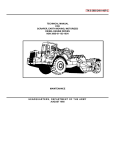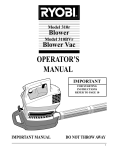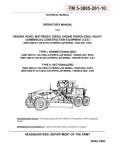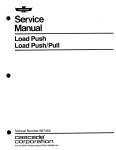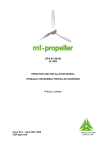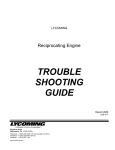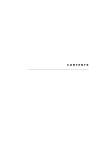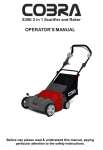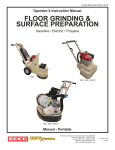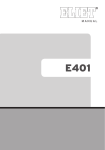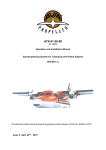Download TM_5-3805-263-14_P-2..
Transcript
TM 5-3805-263-14&P-2 TECHNICAL MANUAL UNIT, DIRECT AND GENERAL SUPPORT MAINTENANCE MANUAL FOR GRADER, HEAVY, ROAD, MOTORIZED, TYPE I NONSECTIONALIZED NSN 3805-01-252-0128 TYPE II SECTIONALIZED NSN 3805-01-251-8252 HEADQUARTERS, DEPARTMENT OF THE ARMY APRIL 1989 TM 5-3805-263-14&P-2 TECHNICAL MANUAL NO. 5-3805-263-14&P-2 HEADQUARTERS DEPARTMENT OF THE ARMY Washington, DC, 14 April 1989 UNIT, DIRECT AND GENERAL SUPPORT MAINTENANCE MANUAL FOR GRADER, HEAVY, ROAD, MOTORIZED, TYPE I NONSECTIONALIZED NSN 3805-01-252-0128 TYPE II SECTIONALIZED NSN 3805-01-251-8252 REPORTING OF ERRORS You can help improve this manual if you find any mistakes or if you know of a way to improve the procedures, please let us know. Mail your letter, DA Form 2028 (Recommended Changes to Publications and Blank Forms) or DA Form 2028-2 located in the back of this manual direct to: Commander, US Army Tank Automotive Command, ATTN: AMSTA-MB, Warren, MI 48397-5000. A reply will be furnished direct to you. TABLE OF CONTENTS General Description and Specifications PART ONE Engine Index . . . . . . . . . . . . . . . . . . . . . . . . . . . . . . . . . . . . . . . . . . . . . . . . . . . . . . . . . . . . . . . . . . . . . . . . . . . . . . . . . . . . . . Chapter 1 Systems Operation - Testing and Adjusting . . . . . . . . . . . . . . . . . . . . . . . . . . . . . . . . . . . . . . . . . . . . . . Chapter 2 Disassembly and assembly. . . . . . . . . . . . . . . . . . . . . . . . . . . . . . . . . . . . . . . . . . . . . . . . . . . . . . . . . . . Chapter 3 Specifications . . . . . . . . . . . . . . . . . . . . . . . . . . . . . . . . . . . . . . . . . . . . . . . . . . . . . . . . . . . . . . . . . . . . . PAGE l-l 1-2 1-80 1-221 PART TWO Power Train Index . . . . . . . . . . . . . . . . . . . . . . . . . . . . . . . . . . . . . . . . . . . . . . . . . . . . . . . . . . . . . . . . . . . . . . . . . . . . . . . . . . . . Chapter 1 Systems Operation - Testing and Adjusting . . . . . . . . . . . . . . . . . . . . . . . . . . . . . . . . . . . . . . . . . . . . . . Chapter 2 Power Shift Transmission - Test and Adjust . . . . . . . . . . . . . . . . . . . . . . . . . . . . . . . . . . . . . . . . . . . . . . Chapter 3 Disassembly and Reassembly . . . . . . . . . . . . . . . . . . . . . . . . . . . . . . . . . . . . . . . . . . . . . . . . . . . . . . . . Chapter 4 Specifications . . . . . . . . . . . . . . . . . . . . . . . . . . . . . . . . . . . . . . . . . . . . . . . . . . . . . . . . . . . . . . . . . . . . . 2-1 2-2 2-32 2-40 2-124 This technical manual is an authentication of the manufacturers commercial literature and does not conform with the format and content specified in AR 310-3, Military Publications. This technical manual does, however, contain available information that is essential to the operation and maintenance of the equipment i TM 5-3805-263-14&P-2 ii TM 5-3805-263-14&P-2 TECHNICAL DATA VEHICLE CHARACTERISTICS 1. NAME: GRADER; ROAD, MOTORIZED. (INC. 05701) 2. WHEEL QUANTITY; 6 3. DRIVE WHEEL QUANTITY; 4 4. STEERABLE WHEEL QUANTITY; 2 FRONT WHEELS 5. FRONT WHEEL TYPE; LEANING 6. PRIMER MOVER TYPE; DIESEL ENGINE 7. ENGINE MANUFACTURER’S NAME; CATERPILLAR TRACTOR CO. 8. ENGINE MODEL NUMBER; MODEL NUMBER 3304DIT 9. BLADE OVERALL LENGTH-THE DIMENSION MEASURED ALONG THE LONGITUDIAL AXIS WITH TERMINATION POINTS AT THE EXTREME ENDS OF THE ITEM; 12 FT 10. MINIMUM CLEARANCE BETWEEN CUTTING EDGE AND GROUND AT MAXIMUM BLADE ELEVATION; 17.25 IN. 11. BLADE MAXIMUM BANK CUTTING ANGLE IN DEGREES; 90° RIGHT OR LEFT 12. BLADE CONTROL METHOD; HYDRAULIC CONTROL 13. AUTOMATIC BLADE CONTROL; NOT INCLUDED 14. BLADE PULL RATING; 18,000 LBS AT 2 MPH ± 0.1 LB WITH A LIMIT OF 15% SLIPPAGE 15. STEERING CONTROL METHOD; HYDRAULIC 16. VEHICULAR TURN RADIUS; 24 FT 17. SPECIAL FEATURES; ROLL OVER PROTECTIVE STRUCTURE, SCARIFIERS, LIFTING ATTACHMENT, BLACKOUT LIGHTS, FRONT AND REAR TOW PINS, CAB 18. MANUFACTURER’S MODEL NUMBER FOR THIS GRADER; 130G iii TM 5-3805-263-14&P2 INTRODUCTION This publication has instructions and procedures for the subject on the front cover. The information and specifications in this publication are on the basis of information that was current at the time this issue was written. Some photographs in this publication show details that may be different from your machine. Also, for some photographs, guards or covers may have been removed for illustrative purposes. Correct operation, maintenance, test and repair procedures will give this product a long service life. Before starting a test, repair or rebuild job, the serviceman must read the respective chapters of the Service Manual, and know all the components he will work on. Your safety, and the safety of others is at all times very important. When you see this symbol in the manual, you must know that caution is needed for the procedure next to it. The symbol is a warning. To work safely, you must understand the job you do. Read all instructions to know what is safe and what is not safe. It is very important to know the weight of parts. Do not lift heavy parts by hand. Use a hoist. Make sure heavy parts have good stability on the ground. A sudden fall can cause an accident. When lifting part of a machine, make sure the machine has blocks at front and rear. Never let the machine hang on a hoist, put blocks or stands under the weight. When using a hoist, follow the recommendation in the manual. Use correct lift tools as shown in illustrations to get the correct balance of the component you lift. This makes your work safer at all times. The specifications, torques, pressures of operation, measurements, adjustments; and other items can change at any time. These changes can effect the service given to the product. Get the complete and most current information before you start any job. When the words “use again” are in the description, the specification given can be used to determine if a part can be used again. If the part is equal to or with in the specification given, use the part again. When the word “permissable” is in the description, the specification given is the “maximum or minimum” tolerance permitted before adjustment, repair and/or new parts are needed. A comparison can be made between the measurements of a worn part, and the specifications of a new part to find the amount of wear. A part that is worn can be safe to use if an estimate of the remainder of its service life is good. If a short service life is expected, replace the part. WARRANTY STATEMENT The Caterpillar 130 G Motor Grader is warranted by Caterpillar Tractor Co. for 15 months or 1500 hours of operation, whichever occurs first. The warranty starts on the date found on the DA form 2408-9 in the log book. Report all defects in material or workmanship to your supervisor, ‘who will take appropriate action through your organizational maintenance shop. iv TM 5-3805-263-14&P-2 TABLE OF CONTENTS PART ONE ENGINE Page INDEX . . . . . . . . . . . . . . . . . . . . . . . . . . . . . . . . . . . . . . . . . . . . . . . . . . . . . . . . . . . . . . . . . . . . . . . . . 1-1 CHAPTER 1 SYSTEMS OPERATION TESTING AND ADJUSTING . . . . . . . . . . . . . . . . . . . . . . . . . . . . . . . . . . . . . . . . . . . . . . . . . . . 1-2 CHAPTER 2 DISASSEMBLY AND ASSEMBLY. . . . . . . . . . . . . . . . . . . . . . . . . . . . . . . . . . . . . . . . . . . . . . . . . . 1-80 CHAPTER 3 SPECIFICATIONS . . . . . . . . . . . . . . . . . . . . . . . . . . . . . . . . . . . . . . . . . . . . . . . . . . . . . . . . . . . . . . . . 1-221 PART TWO POWER TRAIN INDEX . . . . . . . . . . . . . . . . . . . . . . . . . . . . . . . . . . . . . . . . . . . . . . . . . . . . . . . . . . . . . . . . . . . . . . . 2-1 CHAPTER 1 SYSTEMS OPERATION TESTING AND ADJUSTING . . . . . . . . . . . . . . . . . . . . . . . . . . . . . . . . . . . . . . . . . . . . . . . . . . . . CHAPTER 2 POWER SHIFT TRANSMISSION TESTING AND ADJUSTING . . . . . . . . . . . . . . . . . . . . . . . . . . . . . . . . . . . . . . . . . . . . . . . . . . . . . . . . 2-32 CHAPTER 3 DISASSEMBLY AND ASSEMBLY. . . . . . . . . . . . . . . . . . . . . . . . . . . . . . . . . . . . . . . . . . . . . . . . . . . . 2-40 CHAPTER 4 SPECIFICATIONS . . . . . . . . . . . . . . . . . . . . . . . . . . . . . . . . . . . . . . . . . . . . . . . . . . . . . . . . . . . . . . . . 2-124 2-2 PART THREE VEHICLE SYSTEMS INDEX . . . . . . . . . . . . . . . . . . . . . . . . . . . . . . . . . . . . . . . . . . . . . . . . . . . . . . . . . . . . . . . . . . . . . . . . . . 3-1 3-2 CHAPTER 1 HYDRAULIC SYSTEM . . . . . . . . . . . . . . . . . . . . . . . . . . . . . . . . . . . . . . . . . . . . . . . . . . . . . . . . . . . . . . CHAPTER 2 AIR SYSTEM . . . . . . . . . . . . . . . . . . . . . . . . . . . . . . . . . . . . . . . . . . . . . . . . . . . . . . . . . . . . . . . . . . . . . 3-108 CHAPTER 3 DISASSEMBLY AND ASSEMBLY . . . . . . . . . . . . . . . . . . . . . . . . . . . . . . . . . . . . . . . . . . . . . . . . . . . . 3-156 PART FOUR OPERATORS STATION INDEX . . . . . . . . . . . . . . . . . . . . . . . . . . . . . . . . . . . . . . . . . . . . . . . . . . . . . . . . . . . . . . . . . . . . . . . . . . 4-1 CHAPTER 1 OPERATORS STATION AND ELECTRICAL SYSTEM . . . . . . . . . . . . . . . . . . . . . . . . . . . . . . . . . . . . . . . . . . . . . . . . . . . . . . . . . . . . . 4-2 CHAPTER 2 DISASSEMBLY AND ASSEMBLY . . . . . . . . . . . . . . . . . . . . . . . . . . . . . . . . . . . . . . . . . . . . . . . . . . . . 4-66 PART FIVE MAINTENANCE INDEX . . . . . . . . . . . . . . . . . . . . . . . . . . . . . . . . . . . . . . . . . . . . . . . . . . . . . . . . . . . . . . . . . . . . . . 5-1 v (vi Blank) TM 5-3805-263-14&P-2 PART ONE ENGINE TORQUE SPECIFICATIONS: You will find instances in this publication where the manufacturer has used “Meter-Kilograms” or “Centimeter-Kilograms” in place of “Newton-Meters” for the metric torque. In these instances, use the following conversion factors to obtain the metric torque in “Newton-Meters.” lb. ft. x 1.355819 = N•m lb, in. x 0.1129848 = N•m INDEX Page CHAPTER 1 SYSTEMS OPERATION TESTING AND ADJUSTING. . . . . . . . . . . . . . . . . . . . . . . . . . . . . . . . . . 1-2 CHAPTER 2 DISASSEMBLY AND ASSEMBLY . . . . . . . . . . . . . . . . . . . . . . . . . . . . . 1-80 CHAPTER 3 SPECIFICATIONS . . . . . . . . . . . . . . . . . . . . . . . . . . . . . . . . . . . . . . . . . 1-221 1-1 TM 5-3805-263-14&P-2 CHAPTER 1 ENGINE Systems Operation, Testing and Adjusting INDEX Page SYSTEMS OPERATION Air Inlet and Exhaust System . . . . . . . . . . . . . . . . . . . . . . . . . . . . . . . . . . . . . . . . . . . . . . . . . . . . . . . Air Inlet and Exhaust System . . . . . . . . . . . . . . . . . . . . . . . . . . . . . . . . . . . . . . . . . . . . . . . . . . . . . Timing Gears . . . . . . . . . . . . . . . . . . . . . . . . . . . . . . . . . . . . . . . . . . . . . . . . . . . . . . . . . . . . . . . . . . Turbocharger . . . . . . . . . . . . . . . . . . . . . . . . . . . . . . . . . . . . . . . . . . . . . . . . . . . . . . . . . . . . . . . . . . Valves and Valve Mechanism . . . . . . . . . . . . . . . . . . . . . . . . . . . . . . . . . . . . . . . . . . . . . . . . . . . . . Cylinder Head and Valves . . . . . . . . . . . . . . . . . . . . . . . . . . . . . . . . . . . . . . . . . . . . . . . . . . . . . . . . 1-12 1-12 1-13 1-13 1-14 1-14 Basic Block . . . . . . . . . . . . . . . . . . . . . . . . . . . . . . . . . . . . . . . . . . . . . . . . . . . . . . . . . . . . . . . . . . . . . . 1-20 Crankshaft . . . . . . . . . . . . . . . . . . . . . . . . . . . . . . . . . . . . . . . . . . . . . . . . . . . . . . . . . . . . . . . . . . . . 1-20 Cylinder Block . . . . . . . . . . . . . . . . . . . . . . . . . . . . . . . . . . . . . . . . . . . . . . . . . . . . . . . . . . . . . . . . . Pistons, Rings, and Connecting Rods . . . . . . . . . . . . . . . . . . . . . . . . . . . . . . . . . . . . . . . . . . . . . . . 1-20 Cooling System . . . . . . . . . . . . . . . . . . . . . . . . . . . . . . . . . . . . . . . . . . . . . . . . . . . . . . . . . . . . . . . . . . 1-18 Coolant for Air Compressor . . . . . . . . . . . . . . . . . . . . . . . . . . . . . . . . . . . . . . . . . . . . . . . . . . . . . . 1-19 Electrical System . . . . . . . . . . . . . . . . . . . . . . . . . . . . . . . . . . . . . . . . . . . . . . . . . . . . . . . . . . . . . . . . . Charging System Components . . . . . . . . . . . . . . . . . . . . . . . . . . . . . . . . . . . . . . . . . . . . . . . . . . . . Electrical System Schematic . . . . . . . . . . . . . . . . . . . . . . . . . . . . . . . . . . . . . . . . . . . . . . . . . . . . . . Other Components . . . . . . . . . . . . . . . . . . . . . . . . . . . . . . . . . . . . . . . . . . . . . . . . . . . . . . . . . . . . . Starting System Components . . . . . . . . . . . . . . . . . . . . . . . . . . . . . . . . . . . . . . . . . . . . . . . . . . . . . 1-21 1-21 1-24 1-23 1-22 Fuel System . . . . . . . . . . . . . . . . . . . . . . . . . . . . . . . . . . . . . . . . . . . . . . . . . . . . . . . . . . . . . . . . . . . . . . Fuel Flow . . . . . . . . . . . . . . . . . . . . . . . . . . . . . . . . . . . . . . . . . . . . . . . . . . . . . . . . . . . . . . . . . . . . . Fuel Injection Nozzle . . . . . . . . . . . . . . . . . . . . . . . . . . . . . . . . . . . . . . . . . . . . . . . . . . . . . . . . . . . . Fuel Injection Nozzle . . . . . . . . . . . . . . . . . . . . . . . . . . . . . . . . . . . . . . . . . . . . . . . . . . . . . . . . . . . . Fuel Transfer Pump . . . . . . . . . . . . . . . . . . . . . . . . . . . . . . . . . . . . . . . . . . . . . . . . . . . . . . . . . . . . . Governor . . . . . . . . . . . . . . . . . . . . . . . . . . . . . . . . . . . . . . . . . . . . . . . . . . . . . . . . . . . . . . . . . . . . . . Oil Flow for Fuel Pump and Governor . . . . . . . . . . . . . . . . . . . . . . . . . . . . . . . . . . . . . . . . . . . . . 1-6 1-6 1-7 1-6 1-8 1-9 l-8 Engine Design . . . . . . . . . . . . . . . . . . . . . . . . . . . . . . . . . . . . . . . . . . . . . . . . . . . . . . . . . . . . . . . . . . . . 1-5 Lubrication System . . . . . . . . . . . . . . . . . . . . . . . . . . . . . . . . . . . . . . . . . . . . . . . . . . . . . . . . . . . . . . . 1-15 Oil Flow In The Engine . . . . . . . . . . . . . . . . . . . . . . . . . . . . . . . . . . . . . . . . . . . . . . . . . . . . . . . . . . 1-16 Oil Flow Through The Oil Filter and Oil Cooler . . . . . . . . . . . . . . . . . . . . . . . . . . . . . . . . . . . . . 1-16 1-2 TM 5-3805-263-14&P-2 INDEX Page TESTING AND ADJUSTING Air Inlet and Exhaust System Compression Crankcase (Crankshaft Compartment) Pressure Cylinder Head Measurement of Exhaust Temperatures Measurement of Pressure in Inlet Manifold Procedure for Measuring Camshaft Lobes Restriction of Air Inlet and Exhaust Turbocharger Valve Clearance 1-57 1-59 1-58 1-59 1-58 1-57 1-61 1-57 1-58 1-60 Basic Block Connecting Rod and Main Bearings Connecting Rods and Pistons Cylinder Block Cylinder Liner Projection Flywheel and Flywheel Housing Oil Pump Installation Piston Ring Grooves 1-70 1-70 1-70 1-71 1-70 1-71 1-74 1-70 Cooling System Checking Coolant Temperature. Checking Fan Speed Checking Radiator Air Flow. Filler Cap and Pressure Relief Valve 1-64 1-64 1-66 1-66 1-68 1-68 1-67 1-67 1-64 1-69 1-64 1-69 Testing Radiator and Cooling System For Leaks Testing the Cooling System V-Belt Tension `Chart Visual Inspection of the Cooling System Warning Light For Water Temperature Water Temperature Regulators Electrical System Battery Charging System Starting System 1-75 1-75 1-75 1-77 Fuel System Checking Engine Cylinders Separately Checking Engine Timing With 6V3100 Diesel Engine Timing Indicator Group Checking the Plunger and Lifter of an Injection Pump Checking Timing by Fuel Flow Method Checking Timing by Timing Pin Method Fuel Injection Lines Fuel System Inspection 1-37 1-37 1-50 1-42 1-45 1-48 1-42 1-37 1-3 TM 5-3805-263-14&P-2 INDEX 1-4 Page Governor Adjustments . . . . . . . . . . . . . . . . . . . . . . . . . . . . . . . . . . . . . . . . . . . . . . . . . . . . . . . . . . Locating Top Center Compression Position for No. 1 Piston . . . . . . . . . . . . . . . . . . . . . . . . . . . . . . . . . . . . . . . . . . . . . . . . . . . . . . . . . . . . . . Measuring Engine Speed . . . . . . . . . . . . . . . . . . . . . . . . . . . . . . . . . . . . . . . . . . . . . . . . . . . . . . . . . Rack Setting procedure . . . . . . . . . . . . . . . . . . . . . . . . . . . . . . . . . . . . . . . . . . . . . . . . . . . . . . . . . . Removal and Installation of Fuel Injection Pumps . . . . . . . . . . . . . . . . . . . . . . . . . . . . . . . . . . . Testing 8N7005 Fuel Injection Nozzles . . . . . . . . . . . . . . . . . . . . . . . . . . . . . . . . . . . . . . . . . . . . . 1-45 1-53 1-51 1-42 1-38 Lubrication System . . . . . . . . . . . . . . . . . . . . . . . . . . . . . . . . . . . . . . . . . . . . . . . . . . . . . . . . . . . . . . . Oil Pressure . . . . . . . . . . . . . . . . . . . . . . . . . . . . . . . . . . . . . . . . . . . . . . . . . . . . . . . . . . . . . . . . . . Oil Pressure is Low . . . . . . . . . . . . . . . . . . . . . . . . . . . . . . . . . . . . . . . . . . . . . . . . . . . . . . . . . . . . . Too Much Bearing Wear . . . . . . . . . . . . . . . . . . . . . . . . . . . . . . . . . . . . . . . . . . . . . . . . . . . . . . . . . Too Much Oil Consumption . . . . . . . . . . . . . . . . . . . . . . . . . . . . . . . . . . . . . . . . . . . . . . . . . . . . . . 1-62 1-63 1-62 1-63 1-62 Troubleshooting . . . . . . . . . . . . . . . . . . . . . . . . . . . . . . . . . . . . . . . . . . . . . . . . . . . . . . . . . . . . . . . . . 1-25 1-55 SYSTEMS OPERATION GENERAL INFORMATION TM 5-3805-263-14&P-2 ENGINE DESIGN 4.75 in. (120.7 mm) Bore .................................................................. 6.0 in. (152.4 mm) Stroke ................................................................ ................................................................... 4 Number of Cylindera Cylinder Arrangement . . . . . . . . . . . . . . . . . . . . . . . . . . . . . . . . . . . . . . . . . . . . . . . . . . *in-line Firing Order (Injection Sequence) . . . . . . . . . . . . . . . . . . . . . . . . . . . . . . . . . . . . . . . 1,3,4,2 Direction of Flotation (when seen from flywheel end). . . . . . . . . . . . . . . . . . . . . . . . . . . . . . . . . Counterclockwise *No. 1 Cylinder Is Opposite Flywheel End. 1-5 FUEL SYSTEM SYSTEMS OPERATION TM 5-3805-263-14&P-2 FUEL SYSTEM FUEL FLOW Fuel is pulled from fuel tank (1) through primary fuel filter (7) and check valves (8) by fuel transfer pump (9). From the fuel transfer pump the fuel is pushed through secondary fuel filter (10) and to the fuel manifold in fuel injection pump housing (12). A bypass valve in the fuel transfer pump keeps the fuel pressure in the system at 170 to 280 kPa (25 to 40 psi). Constant bleed valve (11) lets a constant flow of fuel go through fuel return line (2) back to fuel tank (1). The constant bleed valve returns approximately 34 liters (9 gal.) per hour of fuel and air to the fuel tank. This helps keep the fuel cool and free of air. There is also a manual bleed valve that can be used when the fuel priming pump is used to remove air from the system. Fuel injection pump (6) gets fuel from the fuel manifold and pushes fuel at very high pressure through fuel line (5) to fuel injection nozzle (4). The fuel injection nozzle has very small holes in 1-6 the tip that change the flow of fuel to a very fine spray that gives good fuel combustion in thecylinder. FUEL INJECTION PUMP The fuel injection pump increases the pressure of the fuel and sends an exact amount of fuel to the fuel injection nozzle. There is one fuel injection pump for each cylinder in the engine. The fuel injection pump is moved by cam (14) of the fuel pump camshaft. When the camshaft turns, the cam raises lifter (11) and pump plunger (6) to the top of the stroke. The pump plunger always makes a full stroke. As the camshaft turns farther, spring (8) returns the pump plunger and lifter to the bottom of the stroke. FUEL SYSTEM When the pump plunger is at the bottom of the stroke, fuel at transfer pump pressure goes into inlet passage (2), around pump barrel (4) and to bypass closed port (5). Fuel fills the area above the pump plunger. After the pump plunger begins the up stroke, fuel will be pushed out the bypass closed port until the top of the pump plunger closes the port. As the pump plunger travels farther up, the pressure of the fuel increases. At approximately 690 kPa (100 psi), check valve (1) opens and lets fuel flow into the fuel injection line to the fuel injection nozzle. When the pump plunger travels farther up, scroll (9) uncovers spill Port (10). The fuel above the pump plunger goes through slot (7), along the edge of scroll (9) and out spill port (10) back to fuel manifold (3). This is the end of the injection stroke. The pump plunger can have more travel up, but no more fuel will be sent to the fuel injection nozzle. SYSTEMS OPERATION TM 5-3805-263-14&P-2 scroll (9) changes the distance the pump plunger pushes fuel between bypass closed port (5) and spill port (10) opening. The longer the distance from the top of the pump plunger to the point where scroll (9) uncovers spill port (10), the more fuel will be injected. To stop the engine, the pump plunger is rotated so that slot (7) on the pump plunger is in line with spill port (10). The fuel will now go out the spill port and not to the injection nozzle. FUEL INJECTION NOZZLE The fuel injection nozzle goes through the cylinder head into the combustion chamber. The fuel injection pump sends fuel with high pressure to the fuel injection nozzle where the fuel is made into a fine spray for good combustion. Seal (2) goes against the cylinder head and prevents leakage of compression from the cylinder. Carbon dam (1) keeps carbon out of the bore in the cylinder head for the nozzle. When the pump plunger travels down and uncovers bypass closed port (5), fuel begins to fill the area above the pump plunger again, and the pump is ready to begin another stroke. The amount of fuel the injection pump sends to the injection nozzle is changed by the rotation of the Pump plunger. Gear (13) is attached to the pump plunger and is in mesh with fuel rack (12). The governor moves the fuel rack according to the fuel needs of the engine. When the governor moves the fuel rack, and the fuel rack turns the pump plunger, Fuel with high pressure from the fuel injection pump goes into inlet passage (5). Fuel then goes through filter screen (4) and into passage (9) to the area below diameter (8) of valve (7). When the pressure of the fuel that pushes against diameter (8) becomes greater than the force of spring (3), valve (7) lifts up. When valve (7) lifts, the tip of the valve comes off of the nozzle seat and the fuel will go through the nine 0.20 mm (.008 in.) orifices (6) into the combustion chamber. The injection of fuel continues until the pressure of fuel against diameter (8) becomes less than the force of spring (3). With less pressure against diameter (8). spring (3) pushes valve (7) against the nozzle seat and stops the flow of fuel to the combustion chamber. 1-7 FUEL SYSTEM TM 5-3805-263-14&P-2 The 8N7005 Fuel Injection Nozzle can not be disassembled and no adjustments can be made. FUEL TRANSFER PUMP SYSTEMS OPERATION The fuel transfer pump is a two-piston pump that is moved by a cam (eccentric) on the camshaft for the fuel injection pump. The transfer pump is located on the right side of the fuel injection pump housing. When the camshaft turns, the cam lifts push rod (10) up. The push rod lifts large piston (9), push plate (6) and small piston (3). As the pistons move up, inlet check valve (5) and outlet check valve (8) close. Pumping check valve (7) in the large piston opens and fuel goes through the holes in the bottom of the large piston and fills the passages and chamber between the bottom of the large piston and outlet check valve (8). As small piston (3) moves up, the pressure of the fuel above the piston increases and flows out of the pump through outlet (4). As the camshaft continues to turn, the cam lowers push rod (10) down. Pumping spring (2) pushes small piston (3), push plate (6) and large piston (9) down. When the piston moves down, inlet check valve (5) and outlet check valve (8) open. Pumping check valve (7) in the large piston closes and the pressure of the fuel below the check valve increases. Fuel now flows through the outlet check valve. A part of the fuel goes through outlet (4) and the remainder goes to the area above small piston (3). As the large piston moves down, fuel from the fuel tank is pulled through inlet check valve (5) into the area between the large and small piston. The pump is now ready to start a new cycle. Bypass valve (1) controls the outlet pressure of the fuel. If the fuel pressure goes beyond 170 to 280 kPa (25 to 40 psi), the bypass valve opens and fuel flows to the inlet of the pump. OIL FLOW FOR FUEL PUMP AND GOVERNOR Oil from the side of the cylinder block goes to support (9) and into the bottom of front governor housing (4). The flow of oil now goes in three different directions. A part of the oil goes to the rear camshaft bearing in fuel pump housing (5). The bearing has a groove around the inside diameter. Oil goes through the groove and into the oil passage in the bearing surface (journal) of camshaft (7). A drilled passage through the center of the camshaft gives oil to the front camshaft bearing and to the thrust face of the camshaft drive gear. Drain hole (6) in the front of ‘fuel pump housing (5) keeps the level of the oil in the housing even with the center of the camshaft. The oil returns to the oil pan through the timing gear housing. 1-8 FUEL SYSTEM SYSTEMS OPERATION TM 5-3805-263-14&P-2 Oil also goes from the bottom of the front governor housing through a passage to the fuel pump housing and to governor servo (2). The governor servo gives hydraulic assistance to move the fuel rack. Oil from the governor returns to the oil pan through a hole in the bottom of the front governor housing and through passages in the support and cylinder block. The remainder of the oil goes through passages to the rear of rear governor housing (3) and into the compartment for the governor controls. Drain hole (8) keeps the oil at the correct level. The oil in this compartment is used for lubrication of the governor control components and the oil is the supply for the dashpot. GOVERNOR The internal parts of the governor are lubricated by oil leakage from the servo and the oil is thrown by parts in rotation. The flyweight carrier thrust bearing gets oil from the passage at the rear of the camshaft. The governor controls the amount of fuel needed by the engine to maintain a desired rpm. The governor flyweights (8) are driven directly by the fuel pump camshaft. Riser (10) is moved by flyweights (8) and governor spring (1). Lever (7) connects the riser with sleeve (2) which is fastened to valve (3). Valve (3) is a part of governor servo (5) and moves piston (4) and fuel rack (6). The fuel rack moves toward the front of the fuel pump housing (to the right in the illustration) when moved in the FUEL OFF direction. 1-9















